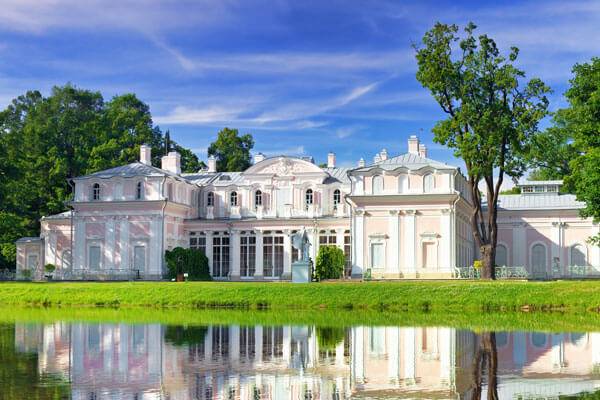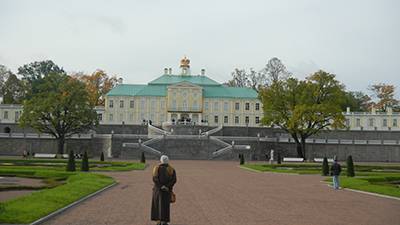
Oranienbaum (Lomonosov) Park and Palace Ensemble was named so after orange trees in the lower park, though another version is that Oranienbaum was named after William, Prince of Orange, and the King of England whom Peter the Great admired so much.
It will take an extra 20 minutes to get there by car after visiting the Russian Versailles, Peterhof.
Unlike the other Imperial palaces, Oranienbaum never fell into hands of the Germans, although it suffered constant bombardment as a tiny enclave held by the Russians throughout the Blockade. After the war both town and park and palace ensemble were renamed Lomonosov, after a Russian polymath who founded a glass factory in the area.
Prince Alexander Menshikov, a close friend of Peter the Great, started building the estate and its Grand Palace (by architects Fontana and Shidel 1710-1725) with a lower park in front of it. The lower park was and is connected with the nearby Gulf of Finland by a 500 meter canal. After Menshikov’s arrest and exile to Siberia the palace was turned into a naval hospital. Later, Peter III (grandson of Peter the Great) became the next owner of the palace and after his assassination Catherine II made the estate one of her holiday stops and created a unique Chinese palace. Catherine the Great (Catherine II) nicknamed it “Her Majesty’s private Dacha”, though she spent only 48 days at the palace during the course of her 34 year reign.
The exterior is quietly baroque while the luxurious yet intimate interior is decorated in a more fanciful Rococo style with pink, blue, and green faux marble, ceiling frescos by Venetian painters, and very beautiful ornate parquet floors. The gem of the palace is Buglework Room with its touch of Oriental exotica – the walls depict peacocks, pheasants and other birds fashioned from beads produced at the Lomonosov factory.

Very close to Grand palace there is extraordinary Sliding Hill Pavilion resembling an oversized slice of wedding cake. This blue and white, three story pleasure pavilion is all that remains of a wooden roller-coaster, that once stretched for over 500 meters along the upper park. In winter Catherine the Great and her guests rode sledges; in summer wheeled carts, offering a unique sensation of height and speed in a flat landscape, where nothing else moved faster than a horse could gallop.
The rooms of Sliding Hill Pavilion were designed by Rinaldi in Rococo style with ceilings, floors and walls covered with faux marble of gentle pink, blue, and yellow colors. The rooms are used for demonstrating a set of Meissen Porcelain depicting mythological scenes symbolizing Russia’s victory over Turkey.
